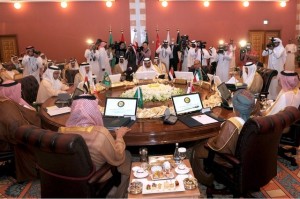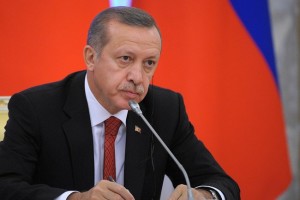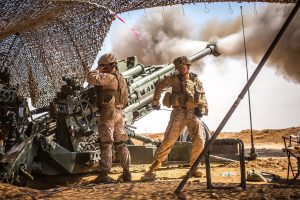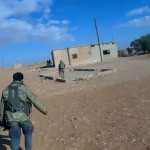by Wayne White
Amidst rumors that Washington finally decided to provide arms at least to selected Syrian opposition fighters, Secretary of State John Kerry announced that the US would do little more than increase its non-lethal aid to the opposition. Rebel disappointment has been intense, and such limited assistance will not have a major impact on the military effectiveness of the opposition or hasten an end to the fighting.
Last week Secretary Kerry said there would be an increase in non-lethal aid to the opposition, with rebel fighters gaining access to military rations and medical supplies. A US official clarified that this aid would only go to carefully vetted rebel groups, with Kerry emphasizing that opposition elements “sharing our values must set an example” by avoiding regime-like brutality and Islamic extremism. In defense of this limited assistance, the US Central Command’s General James Mattis told the Senate this week that the situation inside Syria is currently too complicated for the provision of lethal aid. Finally, earlier this week in a news conference in Qatar (which is believed to be providing munitions to the rebels), Kerry acknowledged that others are doing so, but with “greater guarantees” that arms and ammunition are reaching only moderate groups.
Meanwhile, the European Union upped the ante a bit more than the US by allowing its Syria sanctions to permit the supply of armored vehicles and non-lethal military equipment to opposition combatants if the aim is to protect civilians. Likewise, just yesterday the British seemed to move in step with the EU in saying the UK would provide armored vehicles, body armor and training, though still deeming this assistance as non-lethal.
In parallel to recent Western decisions related to such aid, UN Syrian peace envoy Lahkdar Brahimi, the French, the Russians and the US, have been discussing various seemingly vague notions of bringing representatives of the opposition together with those of the regime in an attempt to end the fighting. The regime now says it is willing to do so, but the rebels, overall, have held back. A pro-Assad Russia clearly views any Western aid to the rebels as disruptive in this context, but efforts aimed at some sort of negotiated solution have been going on for quite some time without any tangible progress.
Predictably, with far higher expectations of Western aid, the opposition has been appalled. In a news conference in Rome with Kerry, the embittered president of the Syrian opposition’s Syrian National Coalition, Moaz al-Khatib, said: “Many sides…focus (more) on the length of the rebel fighter’s beard than the blood of the children being killed.” A rebel commander in the battered northern city of Aleppo also said that lack of arms was the main obstacle to victory over the regime, but rebel fighters had to go on fighting without waiting for such assistance.
Ironically, had there been a decision by the US, the UK and the EU to provide arms to selected, relatively more moderate opposition combatants, even that might not have provided the rebels with a decisive military boost. After over two years of regime brutality, heavy fighting and widespread destruction, large numbers of opposition fighters have been radicalized and many extremist jihadists have entered Syria to join the fight against the Assad regime. For some time now, Muslim extremist rebel groups have been leading the fight and inflicting the most damage on the regime. So supplying moderates exclusively might do little to assist those who have become the proverbial “tip of the spear” in the uprising’s most important battles.
Even prior to this disappointment opposition leaders in exile — but especially rebel fighters and Syrian civilians supporting the uprising inside the country — had become steadily more embittered by two years of Western hand-wringing over providing military help. And no wonder: while caution and indecision has reigned in Western capitals, the death toll in Syria has reportedly reached 70,000 and the number of Syrian refugees in neighboring countries reportedly just topped one million.
Regime forces continue to fight back desperately (and with characteristic brutality) despite assaults by rebel groups in every Syrian province. And, making this violence more like the civil war it has been labeled as by many, the Assad regime still may retain the loyalty of a substantial slice of the population. Of the estimated 12-13% of the populace that is Alawite (Assad’s own community) or vaguely similar Shi’a, most back the regime. Likewise, a large majority of the 10% of Syrians who are Christian have stood by the regime in fear of Muslim extremism. Ethnic Kurds — around 8-9% of the population — have been wary of both sides, providing rebels with only limited help. And, finally, even a minority of Syria’s large Sunni Arab majority is too vested in the regime militarily, in its security services, various businesses, or like-mindedly secular to break with it in the face of a potential Islamist takeover.
So it is possible that maybe as much as 40-45% of the population either has not joined the opposition or potentially represents a pool of manpower and support for Assad’s forces. Continued support for the regime in some important quarters remains a daunting challenge for the rebels, especially since many within pro-regime constituencies are fighting hard alongside the regime because they believe — perhaps with good reason at this point — that they would suffer greatly if the rebels prevail.
The upshot of the latest decision on the part of the US and the West to hold back on precisely what rebels battling inside Syria need most (whether justified or not) is the inevitable prolongation of the mayhem that has been progressively destroying Syria.
Photo: Women walk past destoryed shops in Al Qusayr, Syria. Credit: Sam Tarling/IPS.





